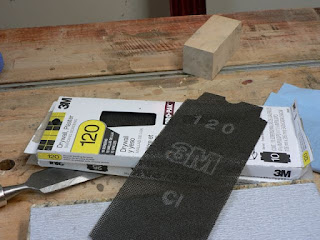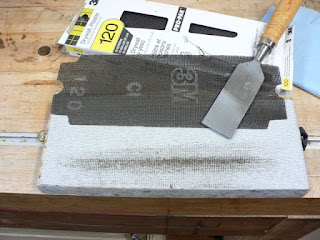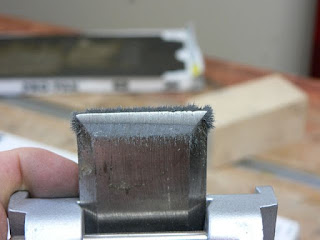I
learned this trick from Mark
Duginske a couple of years ago: drywall mesh is great for
flattening plane soles. It's also great for flattening water stones.
So I wondered to myself: would it also be good as the very coarsest
sandpaper in the “Scary Sharp” method? Turns out the answer is
“kinda, sorta.”
I'll
backtrack a little in case any of this is new to you. Here's a
picture of drywall mesh:
You can
find it in the big box home stores in the same area as the drywall
tools, tape, and joint compound. It is coarse, and the mesh structure
lets sanding dust (or iron filings) fall through so the mesh can keep
cutting. In drywalling, it's used after you've taped and mudded, to
quickly get the surface ready for paint. As you can see from the
photo, it's die cut into a tabbed shape to fit a special holder with
a handle.
“Scary
Sharp” is a phrase used to describe a method of sharpening, using
sandpaper as the abrasive instead of oil stones or water stones. I
think I may have been a witness to the origin of the phrase, which as
far as I can tell was on the rec.woodworking group on usenet
in the early 90's.
Call it
Scary Sharp, or just call it sharpening with sandpaper, it's the
cheapest way to start sharpening, and the most expensive way to
continue. I recommend it to beginners, and I have coached hundreds of
woodworkers to get their first sharp edge with it in my sharpening
classes at Highland Woodworking. All you need is a flat surface to
glue the abrasives to and you're ready. As I wrote this post, I
looked around the web for a good link I could send you to for an
introduction. I don't like any I found, so I'll be
writing an introduction to Scary Sharp Jim's Way later today, after
my bike ride.
Back to
today's story. I tried this out on a Harbor Freight chisel that was
used for the job it's best at, opening up some paint cans and cutting
through some nails. As you can see from this photo, the edge has
become roughly serrated:
First
thing to do is flatten the back. Here I am flattening the back,
and
here's what the back looks like after no more than 64 strokes (I
weigh 185 lbs, so I put a good amount of pressure on it):
I like
this photo, because you can see how the iron filings fall into the
spaces between strands in the mesh.
Next, I
put the chisel in a $10
honing jig from Highland Woodworking and started working on the
bevel. Here's what 32 strokes along the length of the drywall mesh
did to it:
Notice
all the iron filings sticking to the edges like a ferric halo! Can
someone explain to me why the chisel is acting mildly magnetic? But
also notice, the serrations are already almost gone from the edge.
And
furthermore, notice the lighter-colored areas on the abrasive
surface:
These
areas no longer cut, nor do they feel rough. So I assume the abrasive
is absent from these areas, and I assume further that putting high
pressure on a small area of this abrasive strips it off either
mechanically or because of the high temperature - - this
thing got HOT as I worked it, far hotter than drywall would ever get.
By the
time I stripped all the abrasive off all the mesh, though, the bevel
was ready for finer grits. At least I thought it was. The box of 10
mesh pads cost about $8, so I used 80 cents' worth of abrasives to
prepare the chisel. NOTE: 3M also makes an 80-grit silicon carbide sandpaper the same size as the mesh, for the same price. It withstands the bevel-grinding process FAR better than the mesh does.
I
quickly ran the chisel through the grits of silicon carbide wet/dry
sandpaper using water as a lubricant: 180, 220, 400, 600, 800, 1200,
1500, and 2000 grit. It sounds like a lot, but it took less than 5
minutes. Just 32 strokes at each grit, and I was done! (Look for a
separate post on this blog later today -
-I'll show you how.)
As a
test, I tried cutting the end grain of some white birch I
had lying around:
Ooops!
I thought I had eliminated the last little serration from the edge,
but I guess I missed it. And now you all know about it. If you've
ever read Franklin's autobiography, you're probably thinking of a
speckled axe right now. Anyway, as you can see, the surface left
behind is 99% fantastic. I wish you could touch it: it's silky
smooth. One of my criteria for a sharp edge is that it should be able
to make intact shavings in end grain, and I've certainly met that
criterion tonight.











No comments:
New comments are not allowed.